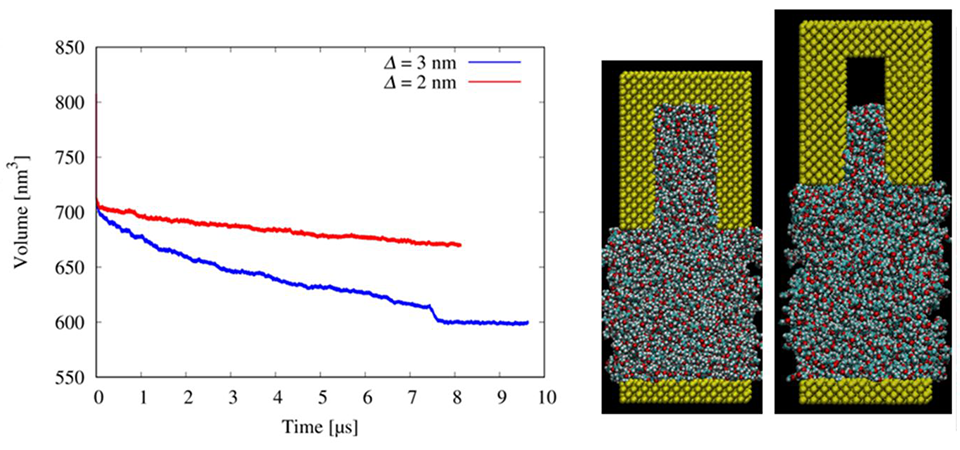2022.08.08 Monday
Towards Higher Nanopatterning Resolution with Molecules that fill Nanogaps Better
Researchers from Japan uncover molecular properties that help fill nanometer-sized gaps in the nanopatterning mold for ultraviolet nanoimprint lithography
Ultraviolet nanoimprint lithography (UV-NIL) is a method of creating patterns at the nanoscale with widespread applications in optoelectronics, photonics, and biology due to its low cost and scalability. However, current UV-NIL resolution is limited below 10 nm, and higher resolutions require a better understanding of the UV-NIL process. In a new study, researchers from Tokyo University of Science, Japan use simulations to unveil molecular properties essential for fine UV-NIL patterning at higher resolutions.
In modern science, nanopatterning is an essential technique for the fabrication of compact devices for electronic, optical, photonic, and biological applications. In this regard, ultraviolet nanoimprint lithography (UV-NIL) shows much promise owing to its low cost and scalability.
The technology is based on creating nanopatterns using UV light on a light-sensitive material called "resist" deposited on a substrate. After depositing the resist on the substrate, a mold nanopattern is pressed into the it. The resist fills this mold and is then cured using UV light, producing the desired nanopattern.
While UV-NIL is a well-explored technique, with simulations providing deep insights into the process, it is still limited to resolutions below 10 nm. This is because resolutions below 10 nm require an understanding of material features at atomic scales. Unfortunately, such feature cannot be explored with traditional simulations, which assume matter to be continuous.
While previous studies have looked at polymer-size effects on UV-NIL, behaviors of the short-chain resist molecules during the filling process remain unclear.
To address this issue, a research group led by Associate Professor Tadashi Ando from Tokyo University of Science (TUS), Japan, performed molecular dynamics (MD) simulations to elucidate the molecular features that govern the filling process at nanoscales. In their study published on July 25, 2022, in Nanomaterials, Dr. Ando and his colleague simulated the process of the filling of 2-nm and 3-nm mold trenches for four different resists, namely N-vinyl-2-pyrrolidone (NVP), 1,6-Hexanediol diacrylate (HDDA), Tri(propylene glycol) diacrylate (TPGDA), Trimethylolpropane triacrylate (TMPTA), and 2,2-Dimethoxy-2-phenylacetophenone (DMPA). Of these, HDDA, NVP, TPGDA, and TMPTA were photopolymers while DMPA was a polymerization initiator. Specifically, the team explored the effects of compositions and viscosities of these molecules on the UV-NIL filling process.
"The simulation results showed that HDDA, NVP/TPGDA/TMPTA, and TPGDA with viscosities lower than 10 mPa.s were able to fill the 2-nm and 3-nm trench widths, while the more viscous and bulkier TMPTA could not," highlights Dr. Ando. Specifically, molecules with viscosity higher than 92 mPa.s could not fill the trenches. Additionally, the researchers compared the two linear-shaped photopolymers, HDDA and TPGDA. The simulations revealed that TPGDA was relatively more flexible, making it more likely to undergo intramolecular crosslinking during UV-curing. Furthermore, these simulation results were in good agreement with empirical rules derived from experiments.
With these remarkable insights, the researchers are excited about the future prospects of UV-NIL. "The findings of our study could provide us useful information for guiding the future selection and design of optimized resists for fine nanopatterning at sub-10 nm resolution with UV-NIL," says Dr. Ando, excited.
We certainly hope his vision is realized soon!

|
Image title: Simulation of the filling process of resist material in UV nanoimprint lithography.
Image caption: In a new study, researchers from TUS, Japan, use molecular dynamics simulations to understand the molecular features of resist materials that makes for better filling of nanometer-sized trenches in the nanopattern mold used in UV nanoimprint lithography.
Image credit: Associate Professor Tadashi Ando from Tokyo University of Science
License type: CC BY 4.0
Image link: https://www.mdpi.com/2079-4991/12/15/2554 
Reference
| Title of original paper | : | Molecular Dynamics Study on Behavior of Resist Molecules in UV-Nanoimprint Lithography Filling Process |
| Journal | : | Nanomaterials |
| DOI | : | 10.3390/nano12152554 |
About The Tokyo University of Science
Tokyo University of Science (TUS) is a well-known and respected university, and the largest science-specialized private research university in Japan, with four campuses in central Tokyo and its suburbs and in Hokkaido. Established in 1881, the university has continually contributed to Japan's development in science through inculcating the love for science in researchers, technicians, and educators.
With a mission of "Creating science and technology for the harmonious development of nature, human beings, and society", TUS has undertaken a wide range of research from basic to applied science. TUS has embraced a multidisciplinary approach to research and undertaken intensive study in some of today's most vital fields. TUS is a meritocracy where the best in science is recognized and nurtured. It is the only private university in Japan that has produced a Nobel Prize winner and the only private university in Asia to produce Nobel Prize winners within the natural sciences field.



About Associate Professor Tadashi Ando from Tokyo University of Science
Tadashi Ando is currently an Associate Professor of Advanced Engineering in the Department of Applied Electronics at the Tokyo University of Science (TUS), Japan. He received his Ph.D. from TUS Graduate School in 2004. His chief areas of interest are simulations of chemical compounds, biophysics, and protein folding simulations. A well-respected researcher, Dr. Ando has 42 publications to his credit.
Funding information
This study was funded by JSPS KAKENHI grant number JP19K04224.

